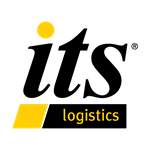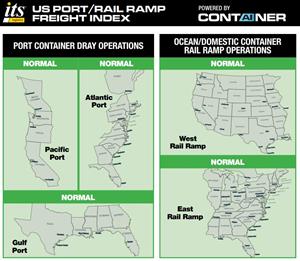ITS Logistics June Port Rail Ramp Index: Trans-Shipment Delays in Asia Signal Impending US Import Surge, Spurring Early Retail Peak
-- Backlogged empty containers and surging inbound freight are set to converge, stressing inland supply chain operations. --
RENO, Nev., June 12, 2025 (GLOBE NEWSWIRE) -- ITS Logistics today released the June forecast for the ITS Logistics US Port/Rail Ramp Freight Index. This month, the index reveals increased volumes making their way to North America with reports of trans-shipment delays in Asia, most notably in Singapore. The change signals rising East-to-West freight volumes, while outside of the terminals, empty termination problems persist, especially in Los Angeles/Long Beach. Furthermore, rail gateways for inland point intermodal (IPI) legs of ocean freight will become more congested rapidly as import surges make their way inland.
“Most ports are running at 60 to 75% capacity, suggesting port operations and vessel congestion should operate efficiently,” said Paul Brashier, Vice President of Global Supply Chain for ITS Logistics. “However, with temporary tariff relief boosting Chinese import volumes in the second half of the retail season, there are growing concerns about whether receiving capacity can effectively absorb these volumes.”
Mid-summer typically marks the onset of back-to-school shipping activity, with fall and winter holiday merchandise still in production or on water. However, the April suspension of the Trump administration’s tariffs on Chinese imports prompted many retailers to accelerate orders on inventory for the second half of the year—prompting another frontloading episode that has sent container rates surging even into early June. Last Friday, the Shanghai Containerized Freight Index (SCFI) reported a week-over-week increase of nearly 31% across all documented markets. West Coast-bound spot rates rose 58% to $6,243 per 40-foot equivalent unit (FEU), while East Coast rates increased 46% to $5,172 per container.
While the rebound in activity is a welcome relief after a 13.4% drop in import volume between April and May, the Global Port Tracker’s June forecast of 2.01 million TEUs still represents a 6.2% year-over-year drop in volume—signaling shippers’ ongoing hesitancy in the face of shifting global politics and economic uncertainty.
On June 11 President Trump announced a forthcoming trade agreement with China, referencing updated tariff rates of 55% on Chinese imports and 10% on United States exports. Until a final agreement is announced, there is still uncertainty in how this will affect the global supply chain for the remainder of 2025.
Outside of the terminal gates, ongoing challenges with empty container termination are placing pressure on domestic supply chain operations—particularly in Southern California. Dwell times remain elevated due to restricted return windows, limited depot availability, and more stringent return policies from ocean carriers. Many carriers have reinstated labor-intensive termination procedures not seen since the post-COVID era, while simultaneously increasing the threshold for detention-free time exemptions. These changes introduce greater administrative complexity for drayage providers and expose shippers to additional per diem or detention charges if they do not carefully review ocean contracts.
The surplus of empty containers—already straining depot space and chassis capacity—is now set to converge with a surge of frontloaded import volume from China, significantly amplifying congestion risks at ports and rail ramps. As grounded empties linger and imports move inland, shippers are likely to encounter reduced equipment availability, increased dwell times, and slower turnarounds. IPI-connected gateways should be of particular note to shippers, as summer holidays like the Fourth of July are marked by increased levels of cargo theft. Altogether, these conditions create a volatile inland environment for this unconventional peak season.
“With container termination challenges compounding port and depot congestion—and a wave of frontloaded imports moving rapidly inland—any inefficiencies could drive significant cost increases through detention costs, delays, and fraud,” Brashier advised. “To maintain control over delivery timelines and minimize risk, shippers should consider leveraging transload, cross-dock, and one-way trucking options that offer more flexibility and security for their freight as we navigate the next few weeks.”
ITS Logistics offers a full suite of network transportation solutions across North America and distribution and fulfillment services to 95% of the U.S. population within two days. These services include drayage and intermodal in 22 coastal ports and 30 rail ramps, a full suite of asset and asset-lite transportation solutions, omnichannel distribution and fulfillment, LTL, and outbound small parcel.
The ITS Logistics US Port/Rail Ramp Freight Index forecasts port container and dray operations for the Pacific, Atlantic, and Gulf regions. Ocean and domestic container rail ramp operations are also highlighted in the index for both the West Inland and East Inland regions. Visit here for a full comprehensive copy of the index with expected forecasts for the US port and rail ramps.
About ITS Logistics
ITS Logistics is one of North America's fastest-growing, asset-based modern 3PLs, providing solutions for the industry’s most complicated supply chain challenges. With a people-first culture committed to excellence, the company relentlessly strives to deliver unmatched value through best-in-class service, expertise, and innovation. The ITS Logistics portfolio features North America's #18 asset-lite freight brokerage, the #12 drayage and intermodal solution, an asset-based dedicated fleet, an innovative cloud-based technology ecosystem, and a nationwide distribution and fulfillment network.
Media Contact
Amber Good
LeadCoverage
amber@leadcoverage.com
A photo accompanying this announcement is available at https://www.globenewswire.com/NewsRoom/AttachmentNg/e8346b59-1561-4f57-8bf2-915da7b81d3f

Legal Disclaimer:
EIN Presswire provides this news content "as is" without warranty of any kind. We do not accept any responsibility or liability for the accuracy, content, images, videos, licenses, completeness, legality, or reliability of the information contained in this article. If you have any complaints or copyright issues related to this article, kindly contact the author above.


